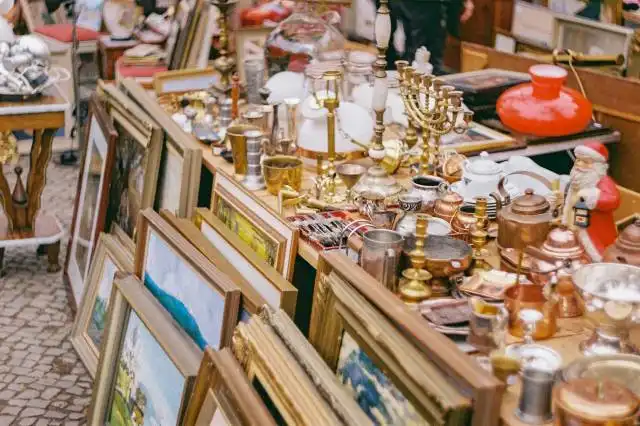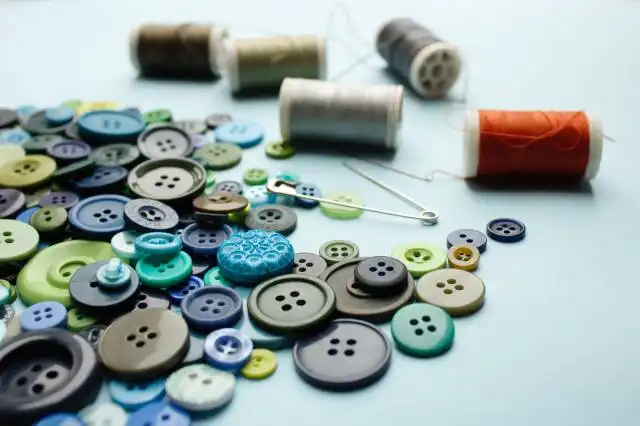Start an Antique Store
Turning Back Time: The Profitable Adventure of Owning an Antique Store
| Updated


ANTIQUE STORE
What if every day at work was like opening up a treasure chest? Dive into the dynamic world of owning an Antique store, where history is the most valuable asset! This business is all about purchasing, collecting, and selling items of value from bygone eras. By buying low and selling high, you not only preserve cherished relics but also turn a delightful profit, making it a perfect venture for those with an eye for the past and a mind for the future.
Jump to Business Plan
RELATED BUSINESS IDEAS
Browse ALL Clothing & Fashion Trends Business Ideas
Discover Your Perfect Domain
Unlock the door to your online success with our hand-picked selection of premium domain names. Whether you're starting a new venture or rebranding an existing one, the right domain can set the tone for your digital presence. Browse through our curated list, each with its unique potential to enhance your brand's visibility and credibility.
ANTIQUE STORE MINI BUSINESS PLAN
This a quick reality check to help you identify the strengths and weaknesses of your business concept before you dive in.
Expected Percent Margin:
- Gross Margin: Antiques vendor's gross margin average between 50-60%.
- Net Profit Margin: Net margins often average between 20-30% after operating costs are considered.
Earnings Expectations:
Depending on location, product range, and level of investment:
- Daily Earnings: Expect earnings of around $100 - $200.
- Weekly Earnings: This equates to around $700 - $1400.
- Monthly Earnings: Which brings the monthly earning to around $3000 - $6000.
- Annual Earnings: Leading to an annual earnings of $36,000 - $72,000.
Actions to Hit Those Numbers:
Inventory Management:
- Initial Investment: At least $10,000-$20,000 for acquiring diverse, quality antique inventory.
- Scanner: Obtain a 'trained eye' for valuable items by studying antiques and building experience.
Marketing and Customer Acquisition:
- Social Media: Post 2-3 times per day showcasing different items with their history to engage followers.
- In-Store Events: Organize monthly events that celebrate the antique community.
Sales and Customer Experience:
- Customer Service: Provide exceptional customer service and knowledgeable staff.
- Handling: Ensure careful handling and shipping of antiques, assuring customers about the safety of the products.
Cost Control:
- Rent: Opt for a store in a location where rent isn't a hefty burden but also accessible.
- Maintenance: Regular maintenance should be conducted to preserve the quality of antique items.
Business Operations:
- Open Hours: Be open at least 5 days a week with opening hours favorable to customers' convenience.
- Vertex of Sales, Purchase, and Value: Continuously balance out the price of acquisition, selling price, and still maintaining substantial value.
These estimates are gross and may fluctuate depending on the antique market, location, and salability of your products. For a closer estimate, further market research is advised.
NOT WHAT YOU HAD IN MIND? Here are more ideas



Browse ALL Clothing & Fashion Trends Business Ideas
Grab Your Business Website Name
Before you get caught up in the whirlwind of setting up your business, invest in a domain name. It's a small but significant step that lays the foundation for your brand and makes it easier for customers to find and trust you. Just like you wouldn't build a house without securing the land first, don't build a business without securing your domain name.
"Why? Can't that wait?" Here's why it shouldn't
Step 1: Determine if the Business is Right for You
Breakdown of Startup Expenses
Before starting an antique store, it is important to understand the costs associated with the business. This includes the cost of rent, insurance, inventory, and any other necessary supplies. It is also important to consider the cost of advertising and marketing, as well as any other fees associated with setting up a business. Additionally, it is important to consider the cost of hiring employees, if necessary. Taking the time to research and understand the cost of starting an antique store is essential to ensure that the business is financially viable.
Breakdown of Ongoing Expenses
Once the antique store is up and running, there are ongoing expenses that must be taken into account. This includes the cost of rent, insurance, inventory, and any other necessary supplies. Additionally, it is important to consider the cost of advertising and marketing, as well as any other fees associated with running a business. It is also important to consider the cost of hiring employees, if necessary. Understanding the cost of running an antique store is essential to ensure that the business is financially viable.
Examples of Ways to Make Money
There are several ways to make money with an antique store. One way is to buy and sell antiques. This can include buying items from estate sales, auctions, or other sources and reselling them for a profit. Another way to make money is to offer services such as appraisals, repairs, or restoration. Additionally, it is possible to make money by offering classes or workshops related to antiques. Finally, it is possible to make money by offering consignment services to individuals or businesses. Taking the time to research and understand the various ways to make money with an antique store is essential to ensure that the business is financially viable.
Step 2: Name the Business
When naming your antique store, it is important to choose a name that is memorable and reflects the type of store you are running. Consider using a play on words or a pun to make your store stand out. Additionally, make sure to research the name you choose to ensure that it is not already being used by another business. You may also want to consider registering your business name with the appropriate government agencies to protect your business from any potential legal issues. Additionally, you may want to create a logo or slogan to accompany your business name to further help your business stand out. Finally, make sure to create a website or social media page for your business to help promote your store and make it easier for customers to find you.
Step 3: Secure Financing
When starting an antique store, it is important to secure financing to cover startup and ongoing expenses. There are several sources of financing available to entrepreneurs. These include traditional bank loans, venture capital, angel investors, and crowdfunding. Bank loans are the most common source of financing for small businesses. They are typically the least expensive option, but require a good credit score and a solid business plan. Venture capital and angel investors are more expensive options, but can provide more capital than a bank loan. Crowdfunding is a relatively new option, and can be a great way to raise money from a large number of people.
Calculating Financing Needs
When calculating financing needs, it is important to consider both startup and ongoing expenses. Startup expenses can include rent for a store location, inventory, and other costs associated with getting the business up and running. Ongoing expenses can include rent, utilities, payroll, and other operational costs. It is important to have a clear understanding of the costs associated with running the business in order to determine the amount of financing needed.
Tips for Securing Financing
When securing financing, it is important to have a clear understanding of the business and its goals. Having a solid business plan is essential, as it will provide potential lenders with an understanding of the business and its potential. It is also important to have a good credit score and a strong understanding of the industry. Finally, it is important to shop around and compare different financing options to ensure the best terms and rates.
Step 4: Obtain Licenses and Permits
When starting an antique store, it is important to obtain the necessary licenses and permits. Depending on the location, the types of licenses and permits required may vary. Common licenses and permits that may be necessary include a business license, a seller's permit, a resale permit, a zoning permit, and a health permit. It is important to contact the local government to determine the exact licenses and permits needed for the antique store.
Obtaining Licenses and Permits
Once the types of licenses and permits needed are determined, the next step is to obtain them. This can be done by visiting the local government office or website. The process for obtaining the licenses and permits may involve filling out an application, providing proof of identity, and paying a fee. It is important to make sure all the licenses and permits are obtained before opening the antique store.
Keeping Licenses and Permits Up to Date
Once the licenses and permits are obtained, it is important to keep them up to date. This may involve renewing the licenses and permits periodically. The local government office or website should have information on how to renew the licenses and permits. It is important to make sure all the licenses and permits are kept up to date to avoid any legal issues.
Professional Assistance
If the process of obtaining the licenses and permits is confusing, it may be beneficial to seek the assistance of a professional. A lawyer or accountant may be able to provide guidance on the process of obtaining the necessary licenses and permits. This may be especially helpful for those who are unfamiliar with the process.
Step 5: Find a Location
When looking for a location for your antique store, there are a few considerations to keep in mind. First, you should think about the size of the space you need. You should also consider the visibility of the location, as well as the cost of rent. Additionally, you should think about the parking situation and the foot traffic in the area. Finally, you should consider the zoning regulations in the area to make sure that your business is allowed to operate in that location.
Leasing or Buying a Space
Once you have identified a few potential locations, you should decide whether to lease or buy the space. If you decide to lease, you should make sure to read the lease agreement carefully and understand all of the terms and conditions. If you decide to buy, you should make sure to get a professional inspection of the property to make sure that there are no major issues. Additionally, you should get a lawyer to review the purchase agreement and make sure that all of the terms are fair.
Negotiating the Lease or Purchase
Once you have decided to lease or buy a space, you should begin the process of negotiating the terms of the lease or purchase. You should make sure to get the best deal possible and to understand all of the terms and conditions. Additionally, you should make sure to get any necessary permits or licenses that are required to operate the business in that location.
Finalizing the Lease or Purchase
Once you have negotiated the terms of the lease or purchase, you should make sure to finalize the agreement. This should include signing the lease or purchase agreement and making any necessary payments. Additionally, you should make sure to get any insurance policies that are required for the business. Finally, you should make sure to get any necessary permits or licenses that are required to operate the business in that location.
Step 6: Stock the Store
When stocking an antique store, it is important to know where to find the best antiques. Antique stores can source items from a variety of places. Estate sales, auctions, flea markets, and online marketplaces are all great places to find antiques. Estate sales are great for finding antiques that have been owned by a single family for generations. Auctions are a great way to find antiques that are rare and valuable. Flea markets are a great way to find antiques that are more affordable. Online marketplaces are a great way to find antiques from all over the world.
Pricing
When pricing antiques, it is important to research the item and determine its value. It is also important to consider the condition of the item and any repairs that may be needed. It is also important to consider the market for the item and what similar items are selling for. It is also important to consider the cost of the item and the potential profit margin. It is important to price items fairly and competitively to ensure that the store is making a profit.
Display
When displaying antiques in the store, it is important to create an inviting and attractive atmosphere. This can be done by arranging the items in an aesthetically pleasing way. It is also important to make sure that the items are properly labeled and that the prices are clearly visible. It is also important to make sure that the items are well lit and that the store is well organized. This will help to create an inviting atmosphere and will help to attract customers.
Step 7: Market the Store
When it comes to marketing an antique store, there are a variety of strategies that can be employed. For example, creating a website and social media accounts to showcase the store’s inventory and services is a great way to reach potential customers. Additionally, using print and radio advertising, as well as attending local events, can be effective in getting the word out about the store. Additionally, offering discounts and promotions can be a great way to attract customers.
Consider Hiring a Professional
While it is possible to market the store on one’s own, it is often beneficial to hire a professional marketing firm to help with the process. A professional can help create a comprehensive marketing plan that can be tailored to the store’s needs and budget. Additionally, they can help create effective advertising campaigns and manage the store’s social media accounts.
Develop a Customer Loyalty Program
Creating a customer loyalty program is a great way to keep customers coming back. This can include offering discounts for repeat customers, as well as offering rewards for referrals. Additionally, offering special events or promotions can be a great way to keep customers engaged and excited about the store.
Utilize Online Resources
In addition to traditional marketing strategies, utilizing online resources is a great way to reach potential customers. This can include creating an online store, as well as using online advertising platforms such as Google Ads and Facebook Ads. Additionally, utilizing search engine optimization (SEO) can help the store’s website rank higher in search engine results.
Step 8: Set Up Accounting
Setting up accounting for a business is an important step in the process of starting an antique store. There are several types of accounting software available, such as QuickBooks, Xero, and FreshBooks. Each of these software programs offers different features and benefits, so it is important to research each one to determine which one is best for the business.
Hiring an Accountant
In addition to using accounting software, it may be beneficial to hire an accountant to help with the financial aspects of the business. An accountant can help to ensure that all of the financial records are accurate and up-to-date. They can also provide advice on how to save money and maximize profits.
Setting Up a Bank Account
Once the accounting software and an accountant have been chosen, the next step is to set up a bank account for the business. This will allow the business to accept payments from customers and manage its finances. It is important to choose a bank that offers low fees and good customer service.
Establishing a Budget
The last step in setting up accounting for the business is to establish a budget. This will help to ensure that the business is spending money wisely and that it is not overspending. The budget should include a breakdown of all expenses, including startup costs, ongoing costs, and any other costs associated with running the business. It should also include a plan for how the business will make money.
Step 9: Hire Employees
When it comes to hiring employees, it is important to find the right people who are passionate about antiques and have the right skills to help your business succeed. Start by creating a job description that outlines the duties and responsibilities of the position. Then, post the job online and in local newspapers. Additionally, you can reach out to local colleges and universities to find potential candidates. Before hiring, make sure to conduct a thorough background check and interview process.
Training Employees
Once you have hired the right employees, it is important to provide them with the necessary training. This should include a comprehensive overview of the business, the products and services you offer, and the policies and procedures you have in place. Additionally, you should provide employees with the resources and tools they need to do their job effectively. Finally, make sure to provide ongoing training and support as needed.
EXPLORE MORE CATEGORIES
Browse ALL Business Idea Categories
TAKE THE NEXT STEPS










